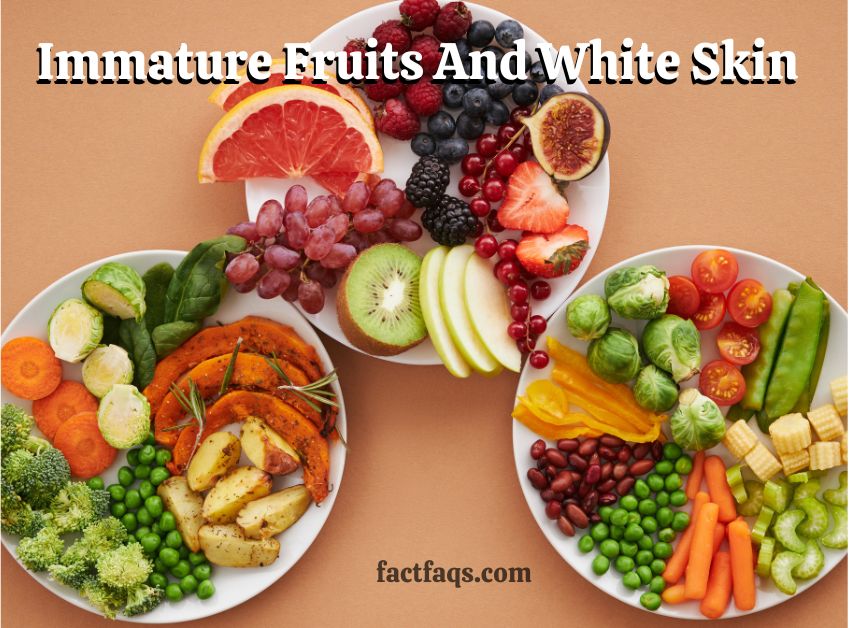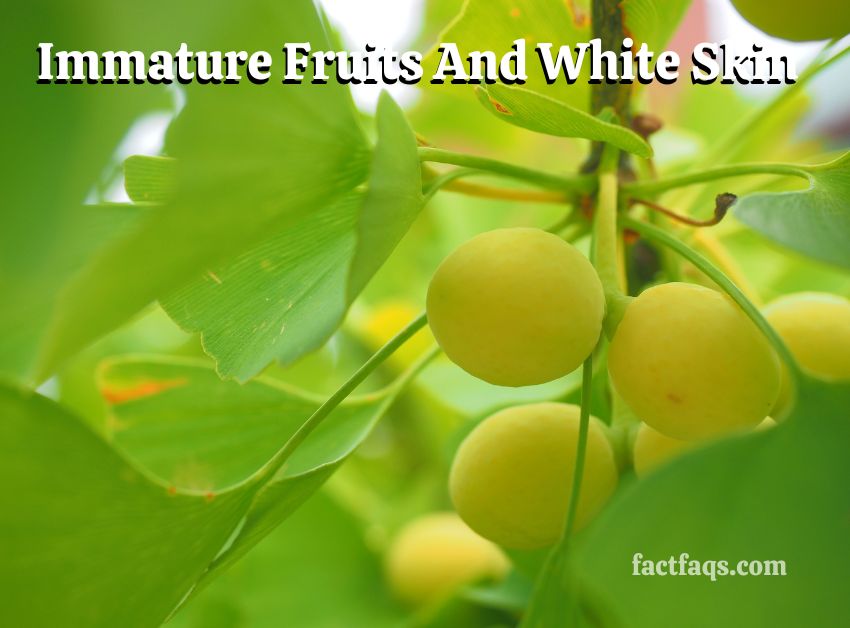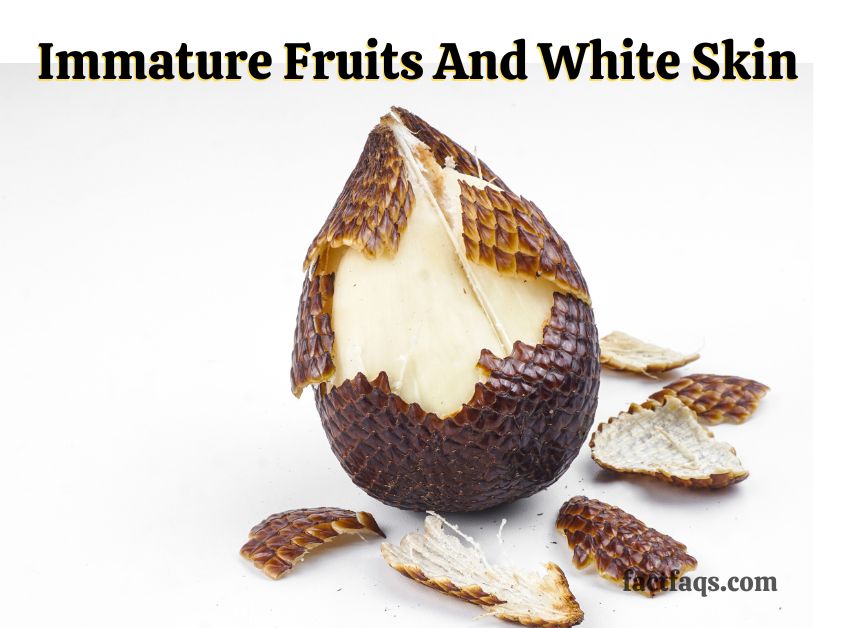Immature fruits and white skin refer to the stage where the fruit is underdeveloped and its skin appears pale or light in color. This phenomenon occurs when chlorophyll synthesis is lacking, resulting in a lack of pigmentation in the fruit’s skin.
There are various reasons why fruit may exhibit immature fruits and white skin, such as the absence of carotenoid pigments or incomplete development in the early stages. Understanding the factors contributing to this condition can provide insights into fruit development and help farmers and researchers improve fruit quality and appearance.
What Causes White Skin In Immature Fruits?
The white skin in immature fruits is caused by the lack of chlorophyll synthesis during fruit development, preventing the production of green chlorophyll and other pigments. This results in a pale or white appearance before the fruit fully ripens.
What Causes White Skin in Immature Fruits? Lack of chlorophyll synthesis during fruit development is a major factor influencing the presence of white skin in immature fruits. The process of chlorophyll synthesis is crucial in giving fruits their characteristic green color. When chlorophyll synthesis does not occur or is hindered, the fruits may appear white or pale in color. This can happen due to genetic factors, environmental conditions, or physiological disorders. However, it is important to note that not all immature fruits with white skin are unhealthy or inedible. Some fruit varieties naturally have white or light-colored skin before ripening and developing their characteristic color. It is always best to refer to specific fruit varieties and their maturity indicators for accurate information on determining the stage of fruit development.

The Science Behind Immature Fruits
The role of pigments in fruit color development
When it comes to understanding the science behind immature fruits, it is essential to know the different stages of fruit growth. Immature fruits are typically light in mass and have a stunted or rubbery texture. Before ripening and developing their characteristic color, certain fruits such as peaches, plums, and grapes have green or white skin. This variation in skin color is due to the lack of chlorophyll synthesis during fruit development. Chlorophyll is responsible for the green color in fruits, while other pigments, such as red, yellow, or orange, contribute to the vibrant coloration of ripe fruits. The connection between immature fruits and white skin is a topic of interest, and scientific evidence supporting their efficacy for skin health is still being studied.
Varieties Of Fruits With White Skin In Their Immature Stage
Varieties of fruits with white skin in their immature stage include peaches, plums, and grapes. These fruits have green or white skin before they ripen and develop their characteristic color. Other fruits with similar characteristics may also have white skin in their immature stage. When it comes to immature fruits, it means that the fruit is light in mass, stunted, or distinctly rubbery in texture. The connection between immature fruits and white skin remains a topic of interest, but scientific evidence supporting their efficacy for skin health is limited. It is important to note that immature fruits should be consumed in moderation and in combination with a balanced diet for overall health benefits.

The Impact Of Immature Fruits With White Skin
When immature fruits have white skin, it can have various impacts on consumer perception and preferences. Some individuals may associate white skin with unripe or underdeveloped fruit, leading to a perception of lower quality or taste. However, there are nutritional benefits to consuming immature fruits that should not be overlooked. Immature fruits often contain higher levels of certain vitamins and minerals compared to their fully ripened counterparts. For example, green bananas are a good source of resistant starch, which can provide several health benefits, including improved gut health and blood sugar control. Moreover, immature fruits can also be cooked or used in recipes that require less sweetness. The choice to consume immature fruits with white skin ultimately depends on individual preferences and their specific nutritional needs.
Also Read:
How To Identify And Select Immature Fruits With White Skin
Tips for Choosing the Best Quality Immature Fruits:
- Visual cues: Look for fruits with white skin that is not fully developed or mature. Immature fruits often have a lighter shade of color compared to fully ripened ones.
- Physical characteristics: Check for firmness and size. Immature fruits tend to be firmer and smaller compared to mature ones. They may have a rubbery texture and feel heavier for their size.
- Consider the variety: Certain fruits, like peaches, plums, and grapes, have green or white skin before they ripen. Familiarize yourself with the specific characteristics of different fruit varieties to make an informed choice.
- Scent: Smell the fruit to see if it has a mild or absent aroma. Immature fruits often have a less pronounced scent compared to ripe ones.
- Ask the vendor: If you are unsure about the maturity of a fruit, don’t hesitate to ask the vendor. They can provide valuable insights and help you make the best selection.
By considering these visual cues and physical characteristics, you can confidently choose the best quality immature fruits with white skin.
The Importance Of Ripening For Fruit Development
| During the ripening process, fruits undergo significant changes in flavor and texture. Immature fruits often lack sweetness and have a more firm and green texture. Ripening allows fruits to develop their characteristic taste and become softer and more enjoyable to eat. Ripened fruits also have higher nutrient availability compared to their unripe counterparts. As the fruit ripens, enzymes break down complex carbohydrates into simpler sugars, making them easier for our bodies to digest and absorb. This increases the nutrient content and makes the fruits more beneficial for our overall health. It is important to allow fruits to fully ripen before consuming them to ensure optimal taste and nutrient intake. Additionally, ripe fruits are more visually appealing with vibrant colors, enticing aromas, and a softer texture. |
Culinary Uses Of Immature Fruits With White Skin
Culinary Uses of Immature Fruits with White Skin
When it comes to culinary uses, immature fruits with white skin offer a unique flavor and texture that can be explored in a variety of recipes and dishes. These fruits, although not fully ripened, can be utilized in both sweet and savory preparations.
One popular way to incorporate immature fruits with white skin is to pickle them. The tartness and crunchiness of the unripe fruit pair well with pickling brine, resulting in a tangy and refreshing pickle. Another option is to sauté or stir-fry these fruits, as the heat can help soften their texture and enhance their natural flavors.
If you are looking for a sweet treat, consider using immature fruits with white skin in desserts such as pies or jams. The slight tartness can provide a pleasant contrast to the sweetness of the other ingredients.
In addition, culinary techniques like marinating, grilling, or roasting can also be used to bring out the flavors and textures of these immature fruits. These methods can help caramelize the natural sugars in the fruit and create a delicious caramelized crust.
Overall, immature fruits with white skin offer a range of culinary possibilities and can add a unique twist to your meals. So, don’t hesitate to explore different recipes and dishes featuring these fruits and let their flavors shine.
Advantages And Disadvantages Of White Skin In Immature Fruits
Advantages and Disadvantages of White Skin in Immature Fruits
- Enhanced visual appeal: White skin can make immature fruits stand out and attract attention in a market setting.
- Unique selling point: Fruits with white skin can be marketed as rare and exotic, appealing to a niche market.
- Versatility: White-skinned fruits can be used in a variety of culinary applications, adding visual interest to dishes.
- Potential for increased health benefits: Some studies suggest that white-skinned fruits may contain higher levels of certain nutrients compared to their colored counterparts.
- Perception of under-ripeness: White skin may be associated with unripeness or immaturity, leading consumers to perceive the fruit as less desirable.
- Increased risk of damage and spoilage: White-skinned fruits may be more susceptible to bruising and spoilage due to their thinner skin.
- Lower market demand: Colored fruits generally have higher demand and are considered more visually appealing by consumers.
- Highlight unique qualities: Emphasize the rarity and exotic nature of white-skinned fruits to create a sense of exclusivity.
- Provide education: Educate consumers about the potential health benefits and culinary versatility of white-skinned fruits to overcome any preconceived notions of under-ripeness.
- Showcase recipes and usage ideas: Share recipes and creative ways to incorporate white-skinned fruits into different dishes to increase consumer interest and engagement.
- Eye-catching packaging: Use visually appealing packaging designs that highlight the uniqueness of white-skinned fruits and differentiate them from other varieties.
- Collaborate with influencers or chefs: Partner with influencers or chefs to create content that showcases the beauty and potential of white-skinned fruits in cooking, baking, or mixology.
Unveiling The Mystery Of Immature Fruits And White Skin
Research and studies on fruit development and coloration have unveiled the mystery of immature fruits and white skin. A recent study suggests that white immature fruit skin color in cucumbers results from the lack of chlorophyll synthesis during fruit development.
For example, certain varieties of peaches, plums, and grapes have green or white skin before they ripen and develop their characteristic color. This connection between immature fruits and white skin remains a topic of interest, with ongoing research and future prospects for potential breakthroughs in understanding the underlying mechanisms.
Understanding the genetic factors and gene prediction associated with white skin in immature fruits can lead to the development of SNP markers for identifying and predicting this characteristic. Additionally, examining the role of fruit color and qtl seq analysis can provide insights into the factors that contribute to fruit maturation and pigmentation.

Frequently Asked Questions On Immature Fruits And White Skin
What Does It Mean When A Fruit Is Immature?
Immature fruit refers to a fruit that is light in mass, stunted, and has a distinctly rubbery texture.
What Causes Immature Fruits To Have White Skin?
Immature fruits may have white skin due to the lack of chlorophyll synthesis during their development, resulting in the absence of green chlorophyll and other pigments that give fruits their characteristic colors. This phenomenon is often observed in certain varieties of peaches, plums, and grapes before they ripen.
Are Immature Fruits Unhealthy To Eat?
I’m
Conclusion
Understanding the connection between immature fruits and white skin is crucial. Certain varieties of fruits, like peaches and grapes, start with green or white skin before developing their characteristic color. Lack of chlorophyll synthesis during fruit maturation can result in white immature fruit skin.
It’s important to further explore the reasons behind this phenomenon to enhance our knowledge and potentially discover new insights into fruit development.
